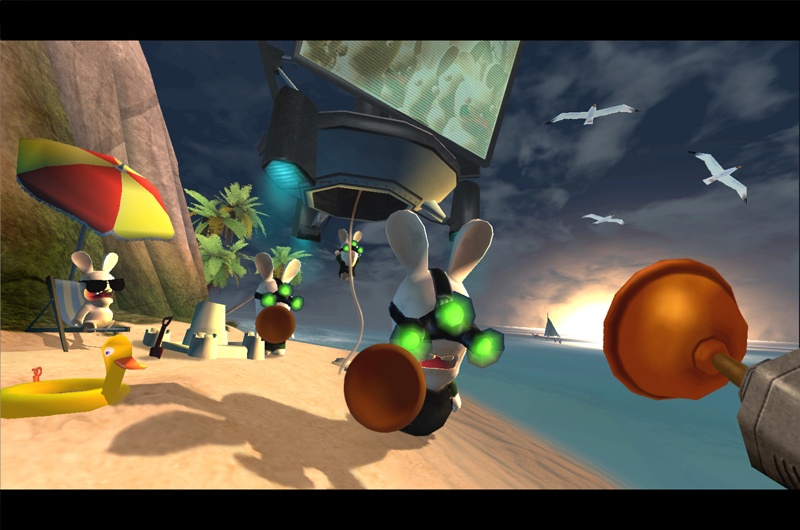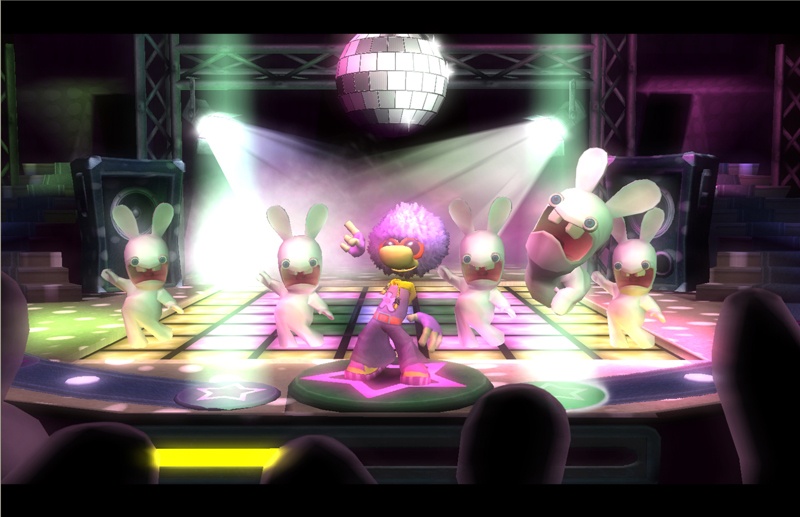Released alongside the launch of the Nintendo Wii, Rayman Raving Rabbids took Ubisoft's mascot platformer hero, Rayman, and shoved him into a world filled with bizarre minigames and evil, screeching bunnies. Not that the Wii launch was hurting for minigame collections, but Raving Rabbids was a success, simply because it combined its hilariously strange characters and the Wii's motion sensing technology into a highly playable and goofily enjoyable game. Now, mere weeks after the Wii release, Raving Rabbids has made its way to the PlayStation 2. This is still very much a minigame collection, but all the motion sensing controls have been replaced with the PS2's analog sticks and trigger buttons. The result is a more conventional series of minigames that succeed in spite of the control shift, due almost entirely to the still hilarious personality of those nasty rabbids.

The Wii version of Raving Rabbids opened with a cutscene depicting the armless Rayman enjoying a picnic with his friends, the globoxes, only to have it interrupted by a group of burrowing rabbids that subsequently kidnap the globoxes and force Rayman to compete in a series of gladiatorial events. For some reason, however, the PS2 version skips this introduction altogether, eschewing context in favor of tossing you into the mix basically blind. There wasn't much of a story to begin with, but not getting a proper introduction to a mode known as "story mode" is a little odd.
The gladiatorial battles consist of many, many minigames. Every single minigame in Raving Rabbids has you using some combination of analog stick movements and button presses to perform completely insane tasks. Trying to list them all would be an exercise in excess. To toss out a few ridiculous examples, one game tasks you with drawing over an outlined image on the screen, which then creates some kind of food for a hungry rabbid, like a can of sardines, or perhaps a baseball; another is basically a game of whack-a-mole, where several rabbids sit inside multiple bathroom stalls, and you have to repeatedly move the pointer back and forth across the screen, tapping the right analog stick to close the stall doors; yet another is a Dance Dance Revolution-style musical sequence where you use the R2 and L2 buttons to hit in time as various bunnies dance onto the stage and hit timed markers; and another still is a hammer-throw minigame where you spin the left analog stick around, while onscreen, Rayman violently spins a cow--not a hammer--around and around, attempting to time the release to hit the playing field and gain as much distance as possible.
All these same games appeared in the Wii version of Raving Rabbids, but they employed the more tactile movements of the Wii Remote and Nunchuk instead of buttons and analog stick movements. This is a game in which motion controls are definitely the preferred control method. It's not that the PS2 controls are bad, but they're just not as engaging. For instance, in the dancing minigame you simply use the R2 and L2 buttons to time the hits, which makes the game really easy, even on the harder difficulty levels. Other games, such as the whack-a-mole bathroom game, are a touch hard to deal with, simply because you have to try to move a cursor back and forth between the different stall doors. With the Wii, the movement was quick, but here it's markedly slower, and it's a bit unwieldy when you're trying to stop on a specific door. And any game that has you quickly moving the analog sticks up and down is borderline broken, simply because these games can sometimes last an awfully long time for the quickness required, and it's not hard to end up losing the rhythm because you accidentally moved the stick too far to the right or left. Basically, it feels like this game wasn't designed with analog sticks and buttons in mind. Even if the Wii version had never been released, the control interface presented here wouldn't translate especially well with the way these minigames are designed. The good news is that the games are still generally fun, but you definitely lose something in translation.
As fun as the minigames are, the comedy of the game is what sells it--and this aspect remains just about as good as ever on the PS2. The rabbids themselves are almost exclusively responsible for this, as they are, without a doubt, hysterical. They're adorably designed, with their dumb stares, high-pitched shrieks, and a penchant for taking comedic bumps. For some reason, they're totally obsessed with plungers and will often use them as a weapon against you. The best parts of the game, both from a gameplay perspective and a comedy perspective, are the first-person rail-shooting missions that take more than a few cues from on-rails light gun games like The House of the Dead and Time Crisis. Each stage is themed after one thing or another, like an Old West ghost town or a creepy cemetery, and the bunnies often take after these scenes, coming after you with cowboy hats and plunger six-shooters, for example. Or, sometimes, the bunnies just go in totally random directions, like the Splinter Cell-styled bunnies that sneak around, wearing Sam Fisher's token night-vision goggles. All the while, you're guiding an aiming reticle and firing off plungers at advancing rabbids. The one odd thing is that it seems like the ability to grab bunnies and use them as shields against oncoming plunger attacks has been nixed in the PS2 version, which is unfortunate, since that was a fun mechanic. Overall, though, these sequences are a great bit of fun, even if they do repeat a few of the same gags a few too many times.
In fact, the single-player mode tends to get a bit repetitive when you move into the later stages, because the game starts tossing in variants of the same minigames you've already played. The process of getting through the single-player game also has a very lather-rinse-repeat kind of progression to it. Each segment is broken out into four available minigames, at least three of which you have to complete to unlock the final game, which is usually one of the first-person shooter sequences or a race of some sort. You keep going through these chunks of games over and over again until you've beaten them, and that's about it. That will take at least a few hours, but once you're done, you probably won't want to go back to it.
It's good, then, that the game supports the ability to go back to individual games you are rather fond of, as well as multiplayer. To be clear, not every minigame in Raving Rabbids can be played in simultaneous multiplayer. Many of the games are sequenced multiplayer, where players take turns and try to get the highest score, and others are exclusively for two players. However, the good news is that the ones that do work simultaneously are quite fun when played with friends. Sometimes the directions for the games aren't clear, specifically in explaining how a game differs in multiplayer versus single-player, but this is one of those games where fumbling around like an idiot often leads to inadvertent fun. And it's not as if anything this game does is complicated.
The rabbids may be an adorable bunch, but Raving Rabbids' graphics aren't quite as pleasant. They're good enough for what the game tries to do, but the technical aspects aren't very impressive. Textures and lighting are sort of bland and washed out, and the game isn't nearly as sharp as it was on the Wii (weird, considering that the Wii version wasn't supersharp, either) However, on the flip side, Raving Rabbids does have a lot of visual charm, simply because of the character design and the way it's animated. The rabbids are bloody adorable, and the way they constantly fall all over the place, run around like screaming lunatics, and generally do silly stuff, it's hard not to fall in love with them. The game also does some nice stuff with level designs, creating some colorful scenery that backdrops the action nicely. Ultimately, while the game's no technical masterpiece, the style does a lot to make up for those shortcomings.

The audio is on a similar level. There's not much that's impressive here, but the cheery in-game music and the rather strange but totally captivating licensed soundtrack (with versions of "Misirlou," "Girls Just Want to Have Fun," and "La Bamba," among others) do a lot to keep things interesting. The totally wacky screams of the rabbids are also oddly amusing. Normally stuff like this comes off as grating, but whoever did the audio for the rabbids totally nailed it.
All told, Rayman Raving Rabbids on the PS2 makes for a good collection of minigames, one made more appealing by the adorably evil rabbids contained within. The PS2 control scheme definitely feels haphazard in spots, but it's mostly fine, and the game's sense of humor goes a long way toward making those control issues forgivable. If you own a Wii and can seek out that version, it's the ideal one to get. But the PS2 version will do you just fine in a pinch.